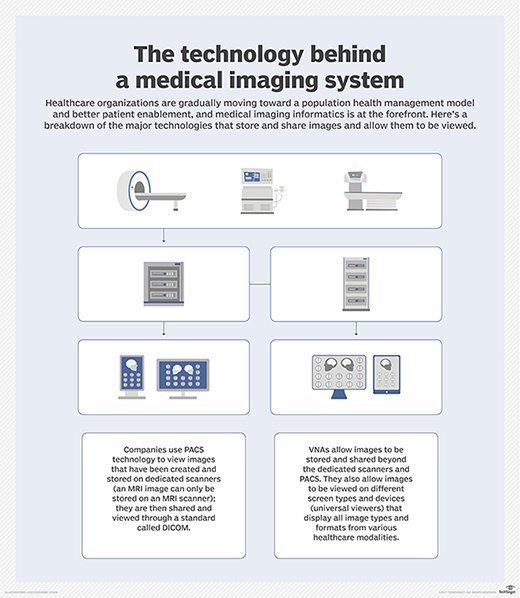What is vendor neutral archive (VNA)?
A vendor neutral archive (VNA) is a medical imaging technology that stores medical images in a standard format and utilizes a standard interface, making them accessible to healthcare professionals regardless of what proprietary system was used to create those images.
Why a vendor neutral archive is important
VNAs are among the most niche digital healthcare technologies around, yet their influence is strong with their growing importance in the medical field. The technology makes it easy to consolidate, store and manage medical images from a wide range of disparate imaging devices and systems from different vendors.
VNA ensures interoperability between the system used to create the images and the system used to access it, which simplifies access to the images for medical professionals. They don't have to switch back and forth between systems, allowing them to make better and faster diagnoses and other important patient-related decisions.
Furthermore, the transition of medical imaging from film to digital media has made it possible to run analytics on stored files. By facilitating easy access and analyses on medical files, VNAs make it possible for healthcare professionals and organizations to provide value-based care (VBC) to patients. This is important because VBC not only enhances patient experiences and improves patient outcomes, but it also improves the efficiency of healthcare service delivery, which helps reduce healthcare costs for both providers and patients.
Uses of vendor neutral archives
Healthcare organizations mainly use VNAs to consolidate, standardize, archive and retrieve images and data from different picture archiving and communication systems (PACS) into a single, easily accessible and interoperable repository. A PACS ecosystem replaces conventional radiological film and typically consists of diverse technologies and components, such as medical imaging devices and patient registry systems that facilitate the display, storage and processing of medical images.
Since VNAs consolidate imaging data into a centralized repository, they make it easy for users to access the images using a standardized interface. Furthermore, all images, regardless of which healthcare system they were created on, are stored in standardized formats, like the Digital Imaging and Communications in Medicine (DICOM) standard. This ensures compatibility with various systems and further eases data accessibility and use.
VNAs also enable users to share and archive imaging data because they are seamlessly integrated into the different PACS, hospital information systems (HIS), radiology information systems (RIS) and electronic health records (EHR) systems that are typically used in healthcare organizations.
VNAs also play an important role in promoting information-sharing among healthcare providers so they can cooperate more effectively in patient care. VNAs support the cross-document sharing (XDS) standard, along with an extension known as XDS-I that handles imaging content. XDS-compliant VNAs enable multiple healthcare delivery organizations to share clinical patient records so they can share important information and coordinate their care activities.
How a VNA works
Medical images are often stored in DICOM formats, an internationally accepted standard to transmit, store, process and retrieve medical imaging information.
That said, different PACS vendors use different syntaxes within DICOM, which makes it difficult for data from one system to work in another vendor's setup. For example, the image-acquiring PACS might use a different luminance or density level, resulting in poor image quality on the image display PACS.
VNA technology deconstructs data from the originating PACS and then migrates the data to the new system under the proper syntax, enabling data integration between the two systems. Moreover, VNAs perform these actions rapidly because they sit between image formats and PACS and use complex algorithms to query the incoming data. The VNA system also modifies the tags associated with DICOM to make the two PACs more compatible and to ensure interoperability between them.
VNAs interface and integrate with data from EHR, clinical reports and other sources through the Health Level Seven International (HL7) standards. The standards provide a consistent framework for the exchange, sharing and retrieval of electronic health information between systems.

Benefits of a vendor neutral archive
A VNA can provide numerous benefits to healthcare organizations.
Using a VNA, personnel at hospitals, clinics and other healthcare facilities can easily access imaging data from different imaging systems, including PACS, RIS and HIS. A centralized repository and standard interface ease user accessibility. Scalability is assured since a VNA is built to accommodate growing volumes of imaging data, a situation that most healthcare organizations are grappling with.
With a VNA, the organization can change over from one PACS to another without having to implement complex, costly and time-consuming data migration methods. The VNA will use the correct syntax and ensure smooth data integration.
Another benefit of VNAs is that they allow for effective control of image data. With VNAs, healthcare organizations can better manage their entire image volume, while also ensuring that they remain readily accessible to authorized users.
VNAs improve clinical and data workflows by consolidating images, removing duplicates and ensuring compatibility between disparate PACS. The images remain easily accessible for future use, making VNAs ideal for long-term data storage and archival.
VNAs ease the integration of new imaging applications, including those not supplied by the organization's current PACS vendor. Also, by reducing the need for multiple storage systems, a VNA can reduce operational costs for the organization.
Finally, many VNAs incorporate strong security and privacy controls to protect sensitive patient information. This not only protects healthcare organizations (and patients) from the damaging effects of data breaches, but also enables them to maintain compliance with stringent healthcare regulations like the Health Insurance Portability and Accountability Act (HIPAA).
Major features of VNA systems
The most prevalent and popular features of VNAs include the following:
- An intuitive user interface and centralized image repository that simplify access to medical imaging information and also optimize image viewing.
- Image Lifecycle Management (ILM) to streamline the way medical images are acquired, stored, used and managed.
- A multi-tenancy architecture that allows for the independent management of internal organizational data from metadata.
- A dual-site configuration, ideally across multiple physical sites (data centers) to protect against failures in one system and ensure high availability.
- Efficient disaster recovery capabilities, including the ability to recover from accidental data deletion.
- Support for external data, such as DICOM, non-DICOM hardware and universal viewers.
- Logging and security options that IT can easily manage.
- Secure cloud data storage that fully complies with all applicable security regulations like HIPAA.
- Seamless integration with the organization's existing PACS and other systems to simplify data retrieval, management and use.
VNA project planning and implementation
As with any software or hardware rollout, planning is important for any VNA adoption project. A healthcare organization planning to adopt a VNA system should establish the goals it aims to achieve with the system. This process requires outlining in detail the planned uses of the technology, as well as aspects such as the following:
- Expected workload capacity of the VNA.
- Range of image consolidation required.
- Required workflow.
- VNA system actionables.
Next, the organization should determine the necessary technical requirements before drafting a request for proposal (RFP) to present to VNA vendors.
Organizations that have acquired and use other health systems (including PACS) and need to integrate existing medical imaging systems with the VNA might consider an open and scalable architecture for the VNA. An open architecture along with a cloud-enabled delivery model allows for data integration and also simplifies interoperability among multiple imaging systems, minimizing compatibility issues and eliminating vendor lock-in.
It's also important to select a scalable VNA to allow for easy expansion as data volumes grow. In addition, scalable and flexible VNAs ease access to imaging information using centralized storage, standardized interfaces and easy data migration.
As part of the VNA license, the healthcare organization should request direct access to the necessary data migration tools and the VNA data dictionary. This will help avoid later issues and also minimize the need to depend on the vendor for future troubleshooting (and ultimately, minimize unnecessary delays and downtime). It's also important to lock in pricing for the data migration with the VNA vendor to ensure better control over VNA costs and eliminate unexpected billing surprises down the line.
VNA customers should also consider the following before initiating a VNA adoption project:
- Establish a strategy and timeline for VNA implementation and get buy-in from all key stakeholders.
- Develop and publish policies to guide VNA operations and use.
- Determine the usage scenario before selecting the VNA solution (clinical use by a single department, multidepartment use, multispecialty use, etc.).
- Ensure connectivity with existing IT infrastructure to minimize future compatibility issues.
VNA market and top vendors
The increasing digitization of medical imaging has increased the popularity of VNA solutions among healthcare organizations worldwide and has led to the expansion of the VNA market.
The following vendors are among the leading VNA providers:
- AGFA HealthCare.
- Ambra Health.
- Carestream Health, Inc.
- Oracle Health (formerly Cerner Corporation).
- Intelerad.
- RamSoft.
- Radsource.
- Wasabi.
- Synapse (Fujifilm Healthcare Solutions).
- GE Healthcare.
- Merge Healthcare.
- Sectra AB.
- Siemens.
Future vendor neutral archive trends
With value-based care becoming more prominent, medical imaging informatics of stored data can provide clues for effective diagnosis and treatment. Modern VNAs are designed for processing large volumes of medical imaging data. Some also integrate AI-driven analytics capabilities that allow healthcare professionals to access real-time, actionable insights.
Connecting electronic records to vendor neutral archives enables healthcare professionals to view images directly from an EHR without having to launch a separate application. PACS can also provide this access, but those systems might not be able to provide viewing of non-DICOM images. By improving interoperability between disparate systems, VNAs will support clinicians and other healthcare personnel with their diagnostic and decision-making goals.
VNAs could also help patients to access their own clinical images. By doing so, patients can pass along image access to their healthcare providers and, thereby, take a more active role in their own treatment and healthcare procedures.
As with other healthcare information, providers are reticent to upload medical images to the cloud, partially because of bandwidth limitations and also because of security concerns. These concerns will ease as more VNAs incorporate strong features for data security and regulatory compliance.
Hybrid cloud is likely to become a popular and even preferred choice for medical image management in healthcare organizations, particularly if organizations want the benefits of cloud data storage (security, scalability, cost-effectiveness) while also ensuring greater data control by maintaining an on-premises control of images.
VNA vs. PACS
PACS are mainly intended for image storage, archiving and retrieval. Whether it's an MRI scan or a CT scan, an ultrasound image or a digital X-ray, a PACS solution allows users to access and view the image created on that particular system. A VNA system, however, is meant to consolidate the images from multiple PACS. This allows a user to retrieve and view the image they need from any PACS using a single interface.
The trademark of VNAs is exchanging image information from various PACS, regardless of the PACS vendor. VNAs reduce isolated groups of storage dedicated to individual PACS and instead promote cross-enterprise data sharing and exchange. By comparison, PACS do not exchange data with each other well.
PACS solutions are usually dependent on a particular vendor's software. Plus, they are more suitable for environments with minimal need for data migration. VNAs don't depend on any single vendor's software and enable data migration between different vendors' PACS, allowing for easy transitions across systems.
VNAs are designed to work with multiple imaging systems and support various vendors' different data formats. Such neutrality allows healthcare organizations to integrate different imaging systems and technologies and create a single repository to access imaging data.
Many healthcare organizations have moved to vendor neutral archives as a logical step to manage medical image access. However, VNAs are unlikely to completely supplant PACS, particularly in smaller healthcare organizations, due to the cost and complexity involved.
Advanced imaging techniques are integral to the healthcare system, playing a significant role in improving diagnostics and monitoring diseases. Explore uses cases and limitations of several healthcare imaging techniques.







